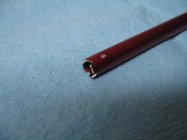A trick for making short work of removing the carbon ring that forms at the end of the chamber is to use an aluminum arrow shaft with notches on the end. Please refer to the picture.
For 22 caliber, an aluminum arrow shaft numbered in the 16xx series having an outside diameter of 0.250’’ should be used. These arrow shafts are tempered aluminum which is hard enough to scrape carbon but not so hard as to cut into the steel chamber. Use an outside case neck chamfer tool to chamfer the end of the arrow shaft so that it will match the taper between the chamber neck and throat of your barrel where the carbon ring forms. Then cut or file notches spaced at 90 deg. around the end of the shaft. This creates four teeth in the end of the arrow. Insert the arrow into the chamber, press forward and give it a few turns. If it is a loose fit, carefully flare the teeth outward with a tapered punch (a common nail set should work) until the teeth fit snugly in the chamber neck. There is a little springiness to the teeth so a snug fit is possible. A bit of trial and error should get your new tool scraping most of the carbon out. A borescope used in between scapings will show you exactly what is happening to the carbon ring. Also, carbon will load up in the teeth so it will be obvious when it is working properly. The arrow shaft is anodized so there is little friction but I prefer to lube the end of the shaft with a bit of bore solvent anyway.
For 6mm chambers an arrow in the 17xx series (.266’’) should work in most cases. For 30 cal. an arrow in the 21xx series (.328’’) should do the trick.
Any feedback you might wish to provide would be appreciated.
For 22 caliber, an aluminum arrow shaft numbered in the 16xx series having an outside diameter of 0.250’’ should be used. These arrow shafts are tempered aluminum which is hard enough to scrape carbon but not so hard as to cut into the steel chamber. Use an outside case neck chamfer tool to chamfer the end of the arrow shaft so that it will match the taper between the chamber neck and throat of your barrel where the carbon ring forms. Then cut or file notches spaced at 90 deg. around the end of the shaft. This creates four teeth in the end of the arrow. Insert the arrow into the chamber, press forward and give it a few turns. If it is a loose fit, carefully flare the teeth outward with a tapered punch (a common nail set should work) until the teeth fit snugly in the chamber neck. There is a little springiness to the teeth so a snug fit is possible. A bit of trial and error should get your new tool scraping most of the carbon out. A borescope used in between scapings will show you exactly what is happening to the carbon ring. Also, carbon will load up in the teeth so it will be obvious when it is working properly. The arrow shaft is anodized so there is little friction but I prefer to lube the end of the shaft with a bit of bore solvent anyway.
For 6mm chambers an arrow in the 17xx series (.266’’) should work in most cases. For 30 cal. an arrow in the 21xx series (.328’’) should do the trick.
Any feedback you might wish to provide would be appreciated.











